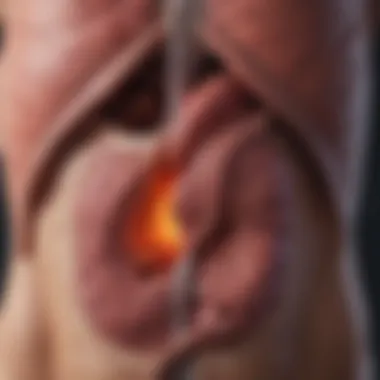Understanding Liver and Bowel Cancer Connections


Intro
The connection between liver and bowel cancer is a crucial area of interest within oncology. Understanding how these two types of cancer interact provides essential insights into diagnostic and treatment strategies. It highlights not only the complexities of cancer development but also the overlapping risk factors that reinforce the importance of comprehensive research.
Liver cancer, primarily hepatocellular carcinoma, and colorectal cancer are among the most common cancers globally. Their occurrence is rising, affecting thousands of lives each year. This increase prompts the need for a deeper exploration into their interrelationship.
The intricate links between these malignancies stem from various biological and lifestyle factors. Liver function impacts digestion and absorption of nutrients, which can influence bowel health. Furthermore, genetic predispositions, chronic diseases, and environmental elements aggravate their co-occurrence. Such factors necessitate a meticulous investigation into their epidemiology and how they might inform clinical practices and therapeutic innovations.
The following sections aim to dissect these connections in detail, focusing on epidemiological trends, common risk factors, diagnostic approaches, and treatment options. By integrating emerging research and clinical insights, this article aspires to present a thorough narrative that is both informative and relevant to professionals in the field, alongside educators and informed readers.
Foreword to Cancer Types
Understanding the various types of cancers is crucial in the field of oncology. This section lays the groundwork for exploring the interconnectedness of liver and bowel cancer. By examining each type, we can identify their unique characteristics and recognize the commonalities that exist between them. It is important to consider how these types of cancers may influence patient care, treatment strategies, and prevention efforts. Through this understanding, medical professionals and researchers can enhance diagnostic frameworks and improve treatment outcomes.
Brief Overview of Liver Cancer
Liver cancer, predominantly classified as hepatocellular carcinoma, originates in the liver cells. This cancer often emerges in individuals with underlying liver disease, such as cirrhosis or chronic hepatitis. Symptoms may not be apparent in early stages, making early detection a challenge. Common symptoms include weight loss, loss of appetite, and jaundice. Risk factors include chronic viral infections, excessive alcohol consumption, and specific genetic conditions. The significance of liver cancer stems from its aggressive nature and often late diagnosis. Treatment options may involve surgery, chemotherapy, or targeted therapies, depending on the stage and overall health of the patient.
Brief Overview of Bowel Cancer
Bowel cancer, also known as colorectal cancer, affects either the colon or the rectum. It often develops from benign polyps that can progress into malignancy over time. Early symptoms may include changes in bowel habits, blood in stool, and abdominal discomfort. A diet low in fiber and high in processed foods is linked to increased risk. Genetic factors also play a role, with conditions such as familial adenomatous polyposis leading to a higher likelihood of developing this cancer. Awareness and regular screening are vital for early detection, as this can significantly improve outcomes. Various treatment methods, including surgery, radiation, and chemotherapy, are tailored to the individual’s condition.
Epidemiology of Liver and Bowel Cancer
Epidemiology plays a crucial role in understanding the burden of liver and bowel cancer. This facet of study reveals incidence rates, survival statistics, and demographic factors that highlight population at risk. Insights from epidemiology can inform prevention strategies and resource allocation for health systems globally. By comprehending these patterns, healthcare professionals can also gain a clearer view of how lifestyle and genetic factors influence the occurrence of these cancers.
Incidence Rates
The incidence rates of liver and bowel cancer vary significantly in different regions. According to recent data, liver cancer is among the leading causes of cancer death worldwide. The global incidence rate of liver cancer is estimated at around 8.2 cases per 100,000 individuals. However, certain regions, especially in East Asia and sub-Saharan Africa, report much higher rates, sometimes exceeding 30 cases per 100,000 population.
In contrast, bowel cancer, which includes colorectal cancer, exhibits a higher overall incidence. It has become one of the most commonly diagnosed cancers. The average incidence for bowel cancer hovers around 24 cases per 100,000 individuals globally, with significant variations across countries and ethnic groups.
Higher incidence rates in developed nations often correlate with lifestyle factors, whereas developing countries may experience results linked to infectious diseases and chronic liver disease.
Global Disparities
Disparities are evident in the epidemiology of liver and bowel cancers across the world. These disparities can be attributed to a variety of factors:
- Socioeconomic Status: Higher rates of liver and bowel cancer are often seen in populations with lower socioeconomic status. Access to healthcare, education, and awareness about these cancers can affect early diagnosis and treatment.
- Infection Rates: The prevalence of hepatitis B and C viruses is particularly high in some regions. Chronic infections can lead to liver cancer. Countries with high infection rates also often have insufficient medical infrastructure to manage these diseases effectively.
- Lifestyle Factors: Dietary habits, physical inactivity, and obesity are more prevalent in wealthier nations. These can increase the risk of bowel cancer. Conversely, in lower-income countries, the risk factors can be related to infections and limited access to screening and treatments.
- Cultural Practices: In certain cultures, attitudes toward screening and cancer treatment can affect early detection and consequential outcomes. These cultural perceptions can lead to delays in seeking medical assistance, worsening the prognosis.
The relationship between lifestyle, access to care, and cancer incidence underscores the need for targeted public health strategies to mitigate the risks associated with liver and bowel cancer.
Pathophysiology
Understanding the pathophysiology of liver and bowel cancer is crucial. It helps explain how these diseases develop, progress, and can affect overall health. The mechanisms rooted in the biology of tissues reveal the complexities of tumor formation. Moreover, recognizing the pathophysiological links provides insights on shared risk factors and treatment approaches. Patients and healthcare providers can make more informed decisions when they grasp these underlying processes.
Mechanisms of Liver Cancer Development
Liver cancer primarily develops from chronic liver diseases like hepatitis and cirrhosis. The primary cells involved in this process are hepatocytes, which can become damaged due to various factors, including viral infections, toxins, and metabolic disorders.
- Viral Infections: Hepatitis B and C play a significant role in promoting liver cancer. They induce inflammation and persistent cell injury.
- Alcohol Consumption: Excessive alcohol intake can lead to liver cirrhosis, increasing cancer risk.
- Metabolic Disorders: Conditions such as non-alcoholic fatty liver disease (NAFLD) create an environment conducive to cancer development.
- Genetic Alterations: Mutations and epigenetic changes affect cellular homeostasis and can drive tumor growth.
These elements contribute to a cascade of events that culminate in the uncontrolled proliferation of liver cells and ultimately tumor formation.
Mechanisms of Bowel Cancer Development
Bowel cancer, also known as colorectal cancer, typically arises through a multistep process involving genetic mutations and changes in the gut environment. The progression from benign polyps to malignant tumors highlights how this cancer develops gradually.
- Adenomatous Polyps: Most bowel cancers begin as adenomatous polyps, which may become cancerous over time.
- Genetic Mutations: Key genes involved include APC, p53, and KRAS. Abnormalities in these genes are linked with cell cycle regulation.
- Inflammatory Conditions: Chronic inflammatory bowel diseases, such as Crohn's disease and ulcerative colitis, increase risk significantly.
- Dietary Factors: High consumption of red and processed meats, along with low fiber intake, can contribute to risk.
Recognizing these pathways is vital for developing early detection methods and prevention strategies. Each mechanism provides opportunities for targeted interventions to reduce incidence rates and improve outcomes.
"A thorough understanding of cancer pathophysiology aids in the development of effective treatment strategies."
By considering both liver and bowel cancer together, researchers can uncover further insights into their interrelation, potentially leading to innovative approaches in both treatment and prevention.
Common Risk Factors
Understanding the common risk factors associated with liver and bowel cancer is crucial for both prevention and awareness. These factors can provide insights into the development of these diseases and guide individuals in making informed lifestyle choices. Recognizing these risk factors enables health care professionals to identify populations at risk and develop targeted interventions. By focusing on environmental factors, genetic predispositions, and lifestyle choices, we can better understand how these elements contribute to the incidence of liver and bowel cancer.
Environmental Factors
Environmental factors play a significant role in the development of both liver and bowel cancer. Exposure to certain chemicals and toxins can increase the risk. For instance, aflatoxins, produced by molds, can contaminate food products. They are particularly harmful to the liver. Similarly, prolonged exposure to certain industrial chemicals, like vinyl chloride, is linked to liver cancer.
Moreover, pollution is another environmental concern. Areas with high air pollution levels have shown increased cancer rates, including bowel cancer. Researchers indicate that pollutants may interfere with normal cellular functions, potentially leading to cancer.
- Key Environmental Factors:
- Aflatoxins from contaminated food.
- Industrial chemicals such as vinyl chloride.
- Air pollution and its byproducts.
Genetic Predispositions
Genetic predispositions are fundamental in understanding susceptibility to liver and bowel cancer. Certain inherited genetic syndromes increase the likelihood of developing these cancers. For liver cancer, conditions such as hereditary hemochromatosis can cause excessive iron accumulation in the body, leading to liver damage and cancer.
Similarly, familial adenomatous polyposis (FAP) is a genetic condition that significantly raises the risk of bowel cancer, often at a young age. Understanding these genetic factors is essential for surveillance and preventive strategies in at-risk individuals.
- Notable Genetic Predispositions:


- Hereditary hemochromatosis.
- Familial adenomatous polyposis (FAP).
- Lynch syndrome, associated with various cancers, including bowel cancer.
Lifestyle Choices
Lifestyle choices have a profound impact on the risk of developing liver and bowel cancer. Diet plays a critical role; a diet high in red and processed meats is associated with an increased risk of bowel cancer. Conversely, consumption of fiber-rich foods, like fruits and vegetables, may lower the risk.
Additionally, alcohol consumption is a well-documented risk factor for liver cancer. Chronic alcohol intake can lead to liver cirrhosis, a significant precursor to liver cancer. Smoking is another lifestyle choice that raises the risk of both cancers, as it contributes to overall carcinogen exposure.
- Influential Lifestyle Choices:
- High intake of red and processed meats.
- Excessive alcohol consumption.
- Tobacco use and smoking.
- Low consumption of fruits and vegetables.
Clinical Presentation
The clinical presentation of liver and bowel cancer is crucial for early detection and effective management. Understanding the symptoms associated with these cancers can facilitate timely diagnosis and improve patient outcomes. Recognizing that both cancers might present with vague or overlapping symptoms emphasizes the importance of detailed patient assessments and clear communication between healthcare providers and patients.
Symptoms of Liver Cancer
Liver cancer often manifests with subtle symptoms, which can make it challenging to identify in early stages. Patients may experience fatigue, weight loss, and a general feeling of being unwell. More specific symptoms can develop as the disease progresses. These can include:
- Abdominal pain on the right side
- Swelling or bulging in the abdomen
- Jaundice, which is a yellowing of the skin and eyes
- Dark urine or pale stools
- Nausea and vomiting
Individuals presenting with these symptoms should undergo further evaluation, especially if there is a known history of liver disease or risk factors such as hepatitis or excessive alcohol consumption. The correlation of these symptoms with potential liver issues highlights the need for vigilance in monitoring liver health.
Symptoms of Bowel Cancer
Bowel cancer, like liver cancer, often has non-specific symptoms that can be confused with other gastrointestinal issues. Some common signs to be aware of include:
- Persistent changes in bowel habits, such as diarrhea or constipation
- Blood in the stool, which can appear bright red or dark
- Abdominal discomfort or cramps
- Unexplained weight loss
- Feeling that the bowel does not empty completely
It is essential for patients to discuss these symptoms with a healthcare provider, especially if they persist or worsen over time. Early intervention can lead to improved survival rates.
Regular check-ups and discussions about potential symptoms can lead to early diagnosis, greatly impacting treatment efficacy and survival prognosis.
The overlapping nature of liver and bowel cancer symptoms necessitates a comprehensive approach to patient history and examination. This understanding not only nurtures better clinical practices but also empowers patients to seek help when needed.
Diagnostic Approaches
Understanding the diagnostic approaches for liver and bowel cancer is crucial. Accurate diagnosis directly influences treatment decisions and can significantly impact patient outcomes. Early detection is vital, especially for cancers like these, which may not present distinct symptoms in earlier stages. The methods employed in diagnosis not only aid in identifying the disease but also help in staging it, determining best therapeutic strategies and possible prognostic outcomes. Let's delve into the specific methods commonly used in clinical practice.
Imaging Techniques
Imaging techniques are foundational in the diagnostic process for both liver and bowel cancer. These non-invasive methods are essential for visualizing physiological and pathological changes within the body. Commonly used imaging modalities include:
- Ultrasound: It is often the first-line imaging modality. This technique uses sound waves to create images of the liver and can help detect masses or tumors. An abdominal ultrasound may reveal liver lesions or abnormalities.
- CT Scans: Computed Tomography uses X-rays to produce detailed cross-sectional images of the body. For liver cancer, CT scans are helpful in assessing tumor size, number, and surrounding structures. They are also valuable for detecting metastasis in bowel cancer.
- MRI: Magnetic Resonance Imaging provides high-resolution images without the use of ionizing radiation. This technique is particularly advantageous for liver lesions, offering detailed visualization that can influence surgical planning.
- PET Scans: Positron Emission Tomography is used to detect cancerous cells' metabolic activity. PET scans are often used in conjunction with CT scans to enhance the diagnostic accuracy, particularly in assessing the extent of bowel cancer.
Each imaging method contributes different types of information, which healthcare professionals utilize to develop a cohesive diagnostic picture. The choice of method generally depends on various factors, including patient's medical history, specific symptoms, and preliminary test result.
"Imaging techniques serve not only to detect tumors but also to evaluate the extent of the disease, highlighting metastases and other complications."
Biopsy Methods
Biopsy methods are critical to confirm the diagnosis of liver and bowel cancer. They involve the removal of tissue samples for histological examination. The primary types of biopsy approaches include:
- Fine Needle Aspiration Biopsy (FNAB): This is often performed on liver lesions detected through imaging. A thin needle is inserted into the lesion to extract a small sample of tissue. FNAB is less invasive and associated with fewer complications.
- Core Needle Biopsy: Similar to FNAB, this method uses a larger needle to obtain a thicker tissue sample. It provides more cellular architecture information, which can improve the diagnostic accuracy.
- Endoscopic Biopsy: For bowel cancer, endoscopy plays a key role. With the aid of a flexible tube with a camera, doctors can visualize the intestinal lining and take targeted biopsies from suspicious areas.
- Surgical Biopsy: In cases where other methods are inconclusive, a surgical biopsy may be necessary. This method allows for a comprehensive examination of the tumor and may be part of a combined surgical intervention for treatment.
Biopsy results guide the next steps in management, including determining the cancer type, grading, and setting a treatment protocol. Proper selection of biopsy technique optimizes results and minimizes patient risk.
Treatment Modalities
Treatment modalities play a crucial role in managing liver and bowel cancers. Understanding these treatment options is essential for both healthcare professionals and patients, as the chosen methods can greatly affect prognosis, survival rates, and quality of life. This section focuses on the surgical options, chemotherapy and targeted therapies, and radiation treatments available for these cancers. Each modality has its own benefits, risks, and considerations, which are vital for making informed decisions.
Surgical Options
Surgery is often the first-line treatment for liver and bowel cancers, particularly when diagnosed at an early stage. For liver cancer, surgical options may include partial hepatectomy or liver transplantation. Partial hepatectomy involves removing the tumor along with a margin of healthy liver tissue. Liver transplantation is another option but is limited by the availability of donor organs. It is generally indicated for patients with early-stage liver cancer and cirrhosis.
In the case of bowel cancer, surgical interventions typically focus on removing the affected portion of the colon or rectum. This may involve a colectomy or proctectomy. The primary goal is to resect the tumor and ensure clean margins.
Considerations for Surgery:
- Surgical candidacy is influenced by patients’ overall health, the stage of cancer, and the presence of underlying liver disease.
- Complications can include bleeding, infection, and potential liver failure, necessitating careful preoperative assessment and postoperative management.
Chemotherapy and Targeted Therapies
Chemotherapy is commonly used in the treatment of both liver and bowel cancers, often as an adjuvant therapy after surgery or for advanced-stage cancers. Traditional chemotherapy agents, such as fluorouracil for bowel cancer, work by inhibiting cancer cell division. In liver cancer, chemotherapeutic agents like doxorubicin and oxaliplatin are utilized to address advanced disease.
Targeted therapies offer a more precise approach compared to conventional chemotherapy. For example, regorafenib and sorafenib have shown effectiveness in advanced liver cancer by targeting specific pathways that promote tumor growth.
Benefits of Chemotherapy and Targeted Therapies:
- These treatments can be administered either intravenously or orally, providing flexibility in management.
- They can help shrink tumors prior to surgery, potentially increasing surgical success rates.
Radiation Treatments
Radiation therapy plays a role in the management of liver and bowel cancers, although its use varies between the two. In liver cancer, external beam radiation therapy or radioembolization may be utilized. Radioembolization involves injecting radioactive beads directly into the blood vessels supplying the tumor, delivering targeted radiation without harming surrounding tissues.


For bowel cancer, radiation is mainly used as a palliative measure or combined with chemotherapy before surgery (neoadjuvant therapy) to decrease tumor size.
Key Points About Radiation Treatments:
- Radiation therapy can alleviate symptoms and improve the quality of life for patients with advanced disease.
- It may also enhance the effectiveness of surgical and systemic treatments, leading to improved outcomes.
Understanding these treatment modalities provides a foundation for comprehending the comprehensive management of liver and bowel cancers. Each option presents unique potential benefits and limitations that must be thoroughly considered.
The Connection Between Liver and Bowel Cancer
The interrelationship between liver and bowel cancer is an increasingly recognized area of study. Understanding this connection is crucial for medical professionals, researchers, and patients alike. Liver cancer often shares common risk factors with bowel cancer, and both types of cancer can influence each other's prognosis and treatment outcomes. This reinforces the importance of a holistic approach in cancer care.
Identifying the shared risk factors and understanding how liver health impacts bowel cancer can significantly improve patient management and outcomes. The implications are broad, ranging from lifestyle changes to tailored screening practices that can help mitigate risks associated with both cancers. Moreover, acknowledging these connections opens pathways for innovative treatment strategies that address both conditions simultaneously.
Shared Risk Factors
Shared risk factors between liver and bowel cancer are numerous and varied. Environmental, genetic, and lifestyle factors intersect in ways that elucidate the possible links between these two cancers.
Common shared risk factors include:
- Obesity: Increased body weight is a major risk factor for both liver and bowel cancer. Excessive fat can lead to liver disease, which has been linked to a higher risk of liver cancer.
- Alcohol Consumption: Heavy drinking is known to increase the risk of liver cancer, and some studies have suggested a correlation with bowel cancer.
- Dietary Choices: Diets high in red and processed meats and low in fiber can elevate the risk for bowel cancer, potentially influencing overall health and liver function as well.
- Chronic Infections: Hepatitis infection for liver cancer can influence bowel health due to inflammatory processes that may predispose to bowel malignancies.
- Smoking: Tobacco use is a known carcinogen that affects both the liver and bowel, contributing to the risk of multiple cancers.
Understanding these shared risk factors is essential for preventative measures and tailored treatment approaches.
Impact of Liver Health on Bowel Cancer Outcomes
Liver health significantly affects bowel cancer outcomes in various ways. The liver plays a crucial role in metabolism and detoxification. When liver function is compromised, it can impact the body's ability to process various medications and even metabolic waste. This can lead to poorer outcomes in bowel cancer treatment and management.
Key considerations include:
- Metabolic Regulation: A healthy liver effectively processes nutrients and drugs, which is vital for patients undergoing chemotherapy for bowel cancer.
- Detoxification Processes: Impaired liver function can lead to the accumulation of toxins, exacerbating the overall health of a bowel cancer patient.
- Impact on Immunity: The liver contributes significantly to the immune response. A weakened liver could lead to reduced immunity, making it harder for patients to fight off cancer and other infections.
"The state of liver health is not just an isolated concern; it intricately ties into the management of bowel cancer, affecting treatment efficacy and patient quality of life."
Preventive Measures
Preventive measures play a crucial role in managing the risk of liver and bowel cancer. Understanding and implementing these measures can significantly reduce the incidence of these malignancies. Key elements include regular screenings and lifestyle modifications, both of which serve as proactive strategies to identify risks early and promote overall health. This section explores these important aspects in detail, providing a roadmap for both individuals and healthcare professionals.
Screening Recommendations
Screening is vital for early detection of liver and bowel cancer. The earlier a cancer is detected, the more effective treatment may be. Various guidelines recommend specific screening ages and modalities for high-risk populations.
- Liver Cancer: Patients with chronic liver diseases, such as hepatitis B or C, should undergo ultrasound screenings biannually or annually. Elevated alpha-fetoprotein (AFP) levels may also prompt additional investigations.
- Bowel Cancer: Individuals aged 45 and above should consider routine screening methods such as colonoscopy or fecal occult blood tests. Those with a family history of bowel cancer should begin screenings earlier.
"Screening is essential, especially for high-risk individuals. Early detection can save lives."
Education about these screening recommendations is paramount. Patients must understand the importance of adhering to their scheduled screenings as early detection can lead to better treatment options.
Lifestyle Modifications
Adjusting lifestyle choices can have a profound impact on reducing the risk of both liver and bowel cancer. Simple yet effective modifications can enhance a person's health and lower cancer risk significantly.
Some key lifestyle changes include:
- Diet: A diet high in fruits, vegetables, and whole grains is beneficial. Limiting processed foods and red meat is also wise.
- Physical Activity: Regular exercise can help maintain a healthy weight, which is crucial, as obesity is a risk factor for both cancers.
- Alcohol Consumption: Reducing or eliminating alcohol intake lowers the risk of liver damage and subsequent cancer development.
- Tobacco Cessation: Quitting smoking decreases the risk of various cancers, including bowel cancer.
Adopting these modifications requires commitment and support. Institutions and healthcare providers should promote these healthy habits through educational programs and community initiatives.
Emerging Research on Liver and Bowel Cancer
The field of cancer research is rapidly evolving, particularly regarding the connections between liver and bowel cancer. Emerging research plays a crucial role in understanding these cancers' complexities and interrelations. Recent studies have highlighted innovative therapies and insights that could change patient management and treatment pathways. This section explores the effects of advancements in research, focusing on their potential benefits and implications.
Innovative Treatment Approaches
Recent advancements in treatment protocols for liver and bowel cancer are gaining attention. Medical professionals are increasingly examining novel strategies that integrate several treatment modalities. These approaches aim not only to improve survival rates but also to enhance patients' quality of life.
- Immunotherapy: A growing area of study focuses on immunotherapy. This treatment harnesses the body's immune system to combat cancer. Clinical trials have shown promise in leveraging immune checkpoint inhibitors for liver cancer, with potential implications for bowel cancer treatments as well.
- Combination therapies: Research continues to explore the benefits of combining various therapies. For instance, concurrent use of targeted therapy with chemotherapy has shown to maximize effects in liver tumor patients. Researchers are hopeful these strategies could also be applicable for individuals suffering from bowel cancer.
- Minimally invasive techniques: Advances in surgical procedures, such as laparoscopic surgeries, reduce recovery time and complications, making treatment safer for patients with either liver or bowel cancer. This shift is crucial as it changes the dynamic of patient management and the focus on post-operative care.
Genomic Studies and Insights
Genomic research is at the forefront of understanding cancer development and treatment. It offers insights into the genetic factors that enhance the risk of both liver and bowel cancers. Studies like these present a fascinating landscape for future research.
- Genomic profiling: Identifying specific genetic mutations allows for tailored treatments based on individual tumor characteristics. In liver cancer, genomic profiling has led to the development of targeted treatments that attack cancer cells while sparing healthy ones. This concept is being extended to bowel cancer, focusing on unique patient profiles to enhance therapy outcomes.
- Molecular markers: The discovery of molecular markers common in both cancers is significant. This can streamline screening and monitoring processes. Such insights can guide preventive measures and help identify at-risk populations early.
"Genomic insights enable a more refined approach to treatment, moving towards personalized medicine that greatly benefits patient outcomes."
- Research collaborations: Ongoing collaborations among institutions foster a broader understanding of cancer pathology across different populations. This collaborative effort promises to yield findings that can impact treatment on a global scale, offering hope for improved strategies in combating liver and bowel cancer.
By emphasizing novel treatment approaches and genomic research, the medical community hopes to unravel the complexity of liver and bowel cancers while paving the way for groundbreaking therapies.
Patient Support and Resources
The patient journey through cancer is often fraught with emotional, physical, and psychological challenges. The importance of support systems cannot be overstated, particularly when considering the interrelationship between liver and bowel cancer. Patients diagnosed with either condition frequently face similar hurdles, including treatment side effects, lifestyle changes, and the need for emotional resilience. Establishing strong patient support networks and providing access to educational resources are crucial components in tackling these challenges.
Support systems can make a significant difference in the lives of patients. They not only provide emotional backing but also offer practical assistance and valuable information. Benefits of strong support networks include:


- Enhanced emotional well-being
- Better coping strategies for managing illness
- Opportunities to connect with others facing similar experiences
- Increased awareness about treatment options and clinical trials
- Access to community services that assist with transportation, meal preparations, and counseling
Support Groups and Networks
Support groups play an essential role for patients navigating liver and bowel cancer. These groups create a space where individuals can share their experiences and learn from one another. Engaging with peers who understand their situation can reduce feelings of isolation and despair. For instance, some online platforms, such as Reddit, provide spaces where members can ask questions, share treatments that work, or express fears.
Moreover, local hospitals and cancer treatment centers typically organize support groups that meet regularly. The structure of these groups can vary from informal gatherings to formal sessions led by healthcare professionals.
Key elements of effective support groups include:
- Facilitated discussion on emotional and physical aspects of cancer
- Guest speakers, including oncologists, nutritionists, and mental health professionals
- Workshops on coping strategies and lifestyle modifications
Educational Resources
Education is a powerful tool for patients dealing with cancer. Access to credible educational resources can empower individuals to make informed decisions regarding their treatments and health. Numerous organizations, including the American Cancer Society, offer a wide range of literature, which covers topics such as treatment options, symptom management, and living with cancer.
In particular, online platforms hold a wealth of information that can be beneficial.
- Wikipedia provides general information on liver and bowel cancer, while also discussing prevention, treatment modalities, and current research findings.
- Britannica is another source that offers easier access to verified data, particularly for patients who may struggle with medical jargon.
"Support systems can drastically change the experiences of patients, turning isolation into connection, and fear into understanding."
By emphasizing these vital aspects of patient care and support, we can pave the way for better outcomes and improved quality of life for those affected by liver and bowel cancer.
Cultural Attitudes Towards Cancer
Understanding cultural attitudes towards cancer can significantly impact prevention, diagnosis, and treatment outcomes. In many societies, cancer carries a stigma. It may be perceived as a death sentence or a punishment for some past wrongdoing. Such perceptions can lead to delays in seeking medical care, as individuals fear social repercussions or are reluctant to acknowledge their illness.
Societies across the globe vary in their willingness to discuss cancer openly. Some cultures tend to keep illnesses private, avoiding discussions that might lead to feelings of shame. This silence can hinder awareness and education about the disease, affecting both individuals and communities.
On the other hand, positive cultural attitudes can promote openness and encourage individuals to seek help. When cancer is discussed more freely, it can lead to better understanding and support systems. This section will examine specific elements affecting societal perceptions of liver and bowel cancer, the benefits of addressing cultural attitudes, and important considerations for healthcare approaches.
Societal Perceptions of Liver and Bowel Cancer
Research shows that societal beliefs play a crucial role in how cancer is perceived and managed. Liver cancer and bowel cancer are often associated with certain lifestyle choices, such as alcohol consumption or diet. These associations may foster the belief that individuals are to blame for their condition, which can lead to stigmatization.
People may avoid discussing cancer if they think it reflects negatively on their character or lifestyle. This can silence conversations about prevention and early detection, making it harder for healthcare professionals to address these cancers effectively. Additionally, the lack of awareness surrounding symptoms can contribute to later-stage diagnoses.
- For instance, stigma surrounding liver cancer may stem from alcohol-related conditions, causing individuals to resist seeking help.
- Similarly, bowel cancer may be viewed as embarrassing, impacting individuals’ willingness to discuss related symptoms or risks.
Impact on Patient Care and Management
Cultural attitudes directly influence patient care and management strategies. When patients feel embarrassed or ashamed about their diagnosis, they may dislike engaging in conversations with healthcare providers. This affects their comfort levels when discussing symptoms, leading to misdiagnoses or late-stage diagnoses.
Health professionals must consider these cultural perspectives when providing care. Educating patients about the reality of cancer can reduce stigma and promote a more supportive environment. This can result in more proactive approaches from patients.
- Benefits of addressing cultural attitudes include:
- Improved patient-provider communication.
- Enhanced screening rates, especially for bowel cancer.
- Better adherence to treatment protocols.
By acknowledging and working with cultural perceptions, healthcare systems can create an environment that fosters open discussions about liver and bowel cancer.
"Addressing cultural attitudes towards cancer is not merely an option; it is a necessity for effective patient management and improved health outcomes."
Future Directions in Research
Research into liver and bowel cancer is essential to develop effective treatment strategies, improve patient outcomes, and advance our understanding of the diseases. Future directions in this area will focus not only on dissecting the molecular pathways involved but also on exploring the interaction between these two cancer types. The connection between liver and bowel cancer might yield insights that can inform interdisciplinary treatment protocols.
There are specific elements within future research directions that stand out. Understanding the genetic and environmental factors that contribute to both cancer types can guide preventive measures and targeted therapies. Additionally, investigating the biochemical interactions between the liver and bowel may reveal mechanisms that explain why these cancers can co-exist in certain populations.
Emphasizing the importance of research in this field can also have wider implications. With the growing incidence of liver and bowel cancers globally, it's crucial to uncover new therapeutic targets that can lead to more personalized treatment plans.
"Continuous research in cancer interrelationships can open doors to innovative solutions that may revolutionize current treatment paradigms."
Investigating Diverse Populations
Investigating diverse populations is an essential component of future research. Understanding how liver and bowel cancers affect different demographics can reveal variations in prevalence, response to treatments, and outcomes. Multi-ethnic studies can help to identify unique genetic predispositions and differing environmental influences that contribute to cancer development.
Moreover, studying diverse populations may help to uncover health disparities related to socioeconomic status, access to healthcare, and cultural beliefs about cancer treatments. This knowledge is vital in designing inclusive and effective intervention strategies to address these inequalities.
Integrating Multidisciplinary Approaches
Integrating multidisciplinary approaches in cancer research is crucial for advancing our understanding of liver and bowel cancer. Collaborations between oncologists, nutritionists, geneticists, and social scientists can generate a more holistic view of the factors affecting these cancers.
A coordinated effort can lead to better clinical management practices that consider a patient’s social context, genetic background, and lifestyle choices. For example, combining genomics with nutritional studies could generate new insights into how dietary choices influence cancer risk or progression. Additionally, multidisciplinary approaches enhance innovation in research methodologies and treatment interventions, ultimately benefiting the patient population most effectively.
Epilogue
The conclusion of this article serves to encapsulate the critical intersections between liver and bowel cancer. Understanding these relationships is essential not only for clinicians but also for patients and caregivers. The synthesis of information presented is aimed at fostering a comprehensive awareness about how these cancers can influence each other, complicate patient management, and affect treatment outcomes.
Summary of Key Findings
In this exploration, various aspects have been discussed that underline the connection between liver and bowel cancer. Key findings include:
- Shared Risk Factors: Both cancers share environmental and lifestyle risk factors such as alcohol consumption, obesity, and certain infections.
- Pathophysiological Links: Mechanisms indicating how liver health can impact bowel cancer progression and vice versa were elaborated.
- Clinical Implications: The interrelationship can lead to a more complex clinical picture, necessitating integrated approaches for diagnostics and treatment.
- Emerging Research: Advancements in genomic studies present new avenues for targeted therapies, enhancing our understanding of these malignancies.
Call for Continued Research and Awareness
The need for ongoing research in this field cannot be overstated. Both liver and bowel cancers are evolving in their patterns of presentation, treatment response, and overall management. Continuous research may yield vital insights that could transform clinical practices and improve patient outcomes. Additionally, raising awareness about these cancers—particularly their interconnected nature—can aid in early detection and intervention strategies, ultimately contributing to better prognoses for affected individuals.
In summary, the intricate relationship between liver and bowel cancers highlights the profound impact they have on each other. Ongoing research and awareness efforts are crucial in navigating the complexities of treatment and improving patient care strategies.







